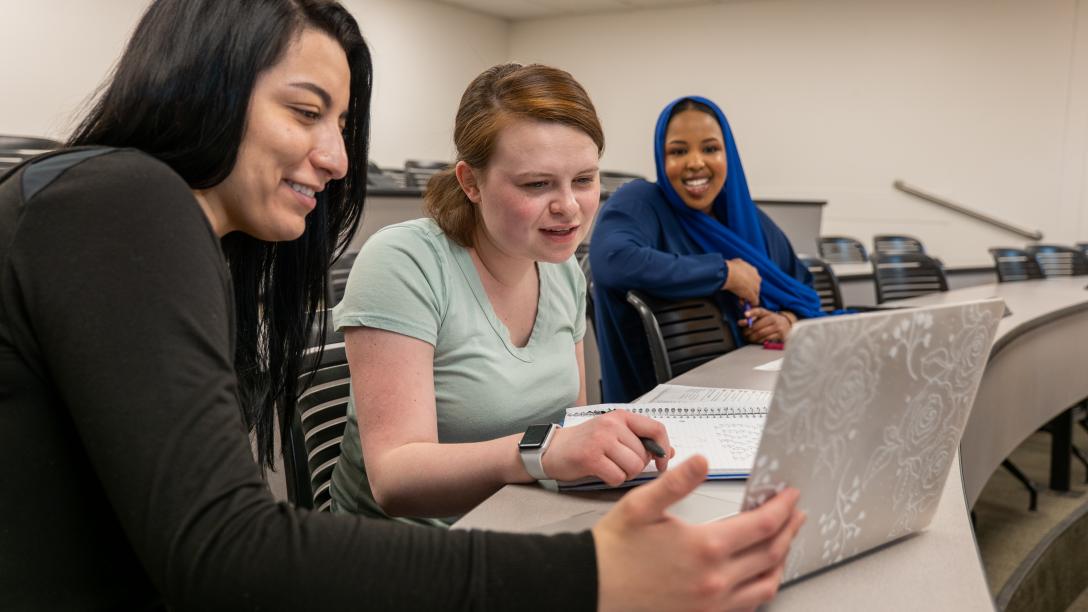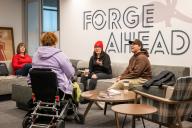Over the past five years, Aims Community College has adopted a Free-to-Student (F2S) initiative, saving students more than $1.5 million on textbooks. This is a growing effort that includes the use and development of Open Educational Resources (OERs) — teaching and learning resources that are freely available to educators and students.
Category
- Press Release
Audience
- Alumni
- Faculty
- General Public
- Staff
- Students
Aims Community College Free-to-Students Initiative Has Saved Students $1.5M on Textbooks

Aims offers approximately 60 classes that utilize OERs each semester. Some courses do not require any outside textbooks, and others have low-cost options under $30. For courses that still require traditional textbooks, a selection is available for checkout at the Learning Commons on each of Aims’ four campus locations at no cost to students. The college expects this number of student options to grow as more faculty and departments adopt OERs.
Doug Strauss, Program Director of the Learning Commons, leads the college's open educational resources implementation team. The group prioritizes using F2S and OER course materials, serving as a resource to faculty and drafting recommendations for the college.
“I'm very proud of the work that our faculty and staff have done so that we can support students not just to save money but also to address equity challenges that students face,” Strauss said.
The F2S initiative at Aims grew out of early success with OER adoption by a few instructors and became part of Aims 2018-2023 strategic plan. The goal set by the strategic plan was to increase OER use by one percent year-over-year for five years. The college has successfully surpassed that measure. This effort was aided by the State of Colorado Open Educational Resources Grant Program, which has allowed Aims to provide faculty with funding to create materials, explore and curate teaching and learning resources, and redesign courses to use free resources.
A few OER textbooks have been published by Aims faculty, such as Responding to Emergencies: Skills Manual by Heather Brown and A Handbook of Classical Rhetoric for Advanced Composition by Ty Cronckhite.
The creation and adoption of OER materials often lead to a change in the structure of courses. Aims provides resources for faculty to work with a learning experience designer who doesn’t just guide them in choosing books and materials and how to look at the instruction differently. The faculty also has an opportunity to work with a librarian to help collect materials and assist with publishing OER materials.
Jim Hutchinson, a Learning Experience Designer at Aims, works with faculty throughout the college to redevelop courses using an approach incorporating OERs. He sees one of the significant benefits is offering freedom for the instructors and more strategically structuring classes to meet learning objectives.
“When we become more purposeful about the materials we use, it's a much more aligned and engaging course,” Hutchinson said. “Museums curate their collections, and instructors when they develop courses, curate materials. It’s a more involved process, but the outcome is so much better.”
Departments such as Early Childhood Education have worked towards using OER materials exclusively in most of their courses. The team worked to compile an extensive collection of credible videos, journal articles and blogs. “Textbooks go this broad on everything and now we can focus on what is relevant in the world out there,” said Laura Killen-Wing, instructor of Early Childhood Education. She also has students research to find more resources, many of which have been used in classes the following semesters. “We're training them to find relevant information and they can continue their learning and research as they go along.”
Faculty are free to use, adapt, and redistribute OERs to fit their specific course needs, making the classes more current and focused on what students need to learn. Aims biology professor Emma Murray is passionate about developing her science courses with OER in mind. “I feel more in control of the resources I give students.” She finds the ability to tailor resources to course outcomes a major benefit. “Traditionally, you get a giant textbook and you're teaching the textbook and you're forced to go along with the way the textbook is.”
Murray recently developed, wrote and illustrated a workbook for biology courses and found it rewarding to create. “It takes time and energy and passion,” she said. With this experience under her belt, she is collaborating with other science department faculty to develop and provide illustrations for lab manuals in areas such as physics and geology.
OER Promotes Education Equity and Positive Outcomes at Aims and Beyond
OER can reduce inequalities in education by providing access to high-quality materials to all students. A 2019 U.S. PIRG Education Fund survey found that 63 percent of students skipped buying textbooks. The same study found that 90 percent of students worried that not having the books would negatively impact their grades. Aside from the cost, there are other barriers for students getting materials on the first day of class, such as a publisher or bookstore running out of books.
Strauss applauds the inclusivity of these materials in a higher educational setting. “When the books are available on the first day of class, everybody is on an equal playing field. That is an equity issue when it comes to having students have the materials and anything else they need to succeed.”
Hutchinson sees frustrations in students when using traditional textbooks.
“They often have to buy these $300 textbooks and are often not utilized heavily. Very few of us keep those books and you go and sell them back and sometimes you don't even get your money back because they came out with the new version.”
Students have provided good feedback about the move to more OER textbooks and resources. “Students are interested in saving money, but they appreciate that they succinctly give them what they need for the class,” Murray said.
Professor and Chair of Early Child Education Christine Wiedeman has received positive feedback as well. “Students have been thrilled; they've been thankful. They're grateful because it's relevant material.”
Aims Community College values affordability, equity and student success, which will help propel the use of more OER materials moving forward. The college's open educational resources implementation team is exploring ways to grow this movement at Aims and continue obtaining funding to ensure these initiatives will endure.
To learn more about the Aims Free-to-Student (F2S) initiative, please visit aims.co/free-textbooks.


